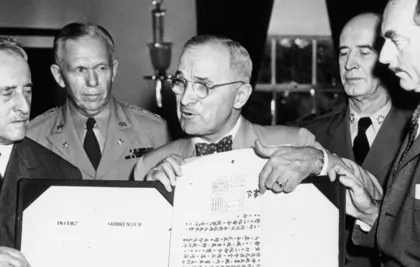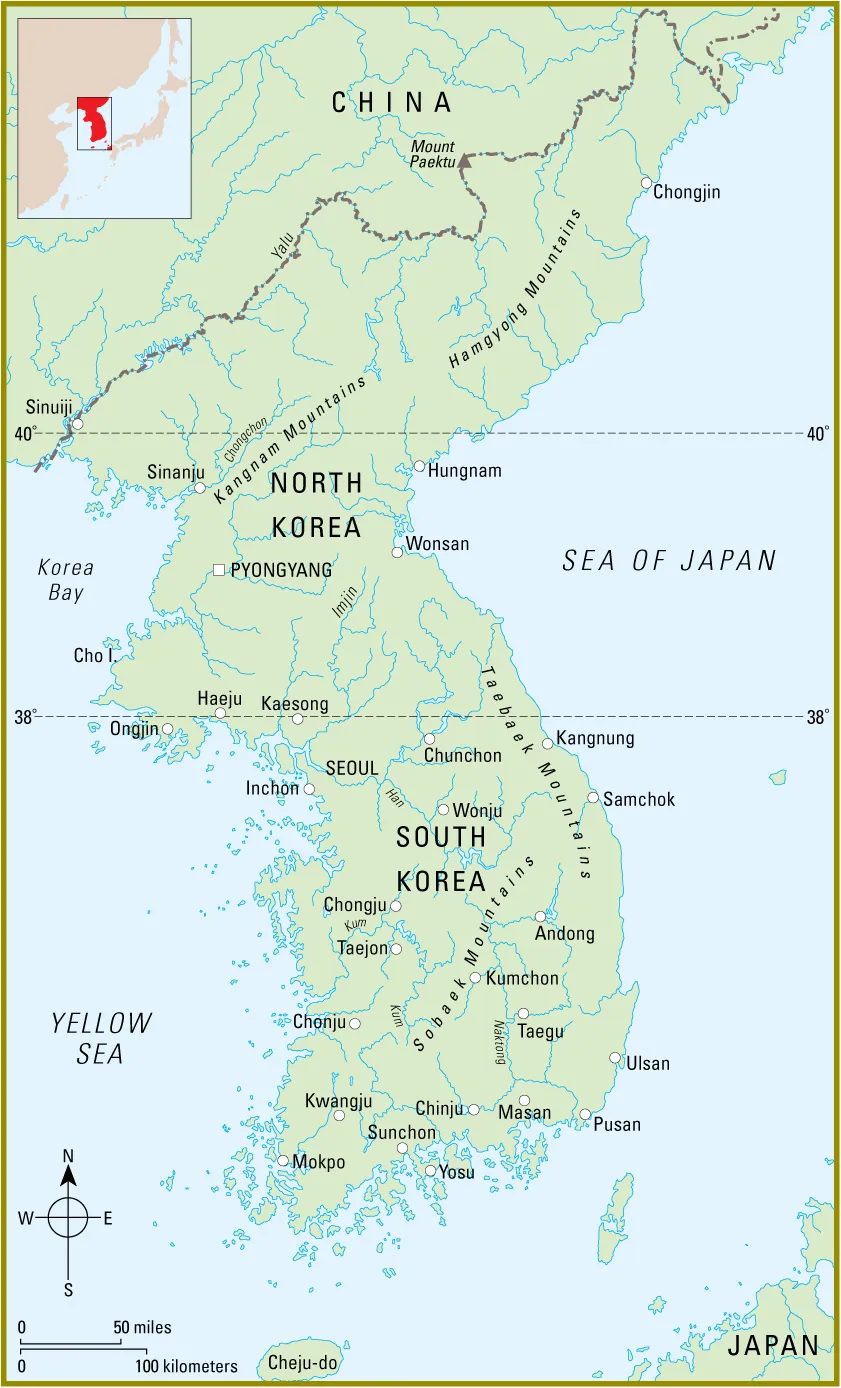
- English
- ePUB (mobile friendly)
- Available on iOS & Android
eBook - ePub
The Korean War
About this book
The Korean War describes the conflict between communist North Korea and U.S.-supported South Korea for control of the Korean peninsula.
Frequently asked questions
Yes, you can cancel anytime from the Subscription tab in your account settings on the Perlego website. Your subscription will stay active until the end of your current billing period. Learn how to cancel your subscription.
At the moment all of our mobile-responsive ePub books are available to download via the app. Most of our PDFs are also available to download and we're working on making the final remaining ones downloadable now. Learn more here.
Perlego offers two plans: Essential and Complete
- Essential is ideal for learners and professionals who enjoy exploring a wide range of subjects. Access the Essential Library with 800,000+ trusted titles and best-sellers across business, personal growth, and the humanities. Includes unlimited reading time and Standard Read Aloud voice.
- Complete: Perfect for advanced learners and researchers needing full, unrestricted access. Unlock 1.4M+ books across hundreds of subjects, including academic and specialized titles. The Complete Plan also includes advanced features like Premium Read Aloud and Research Assistant.
We are an online textbook subscription service, where you can get access to an entire online library for less than the price of a single book per month. With over 1 million books across 1000+ topics, we’ve got you covered! Learn more here.
Look out for the read-aloud symbol on your next book to see if you can listen to it. The read-aloud tool reads text aloud for you, highlighting the text as it is being read. You can pause it, speed it up and slow it down. Learn more here.
Yes! You can use the Perlego app on both iOS or Android devices to read anytime, anywhere — even offline. Perfect for commutes or when you’re on the go.
Please note we cannot support devices running on iOS 13 and Android 7 or earlier. Learn more about using the app.
Please note we cannot support devices running on iOS 13 and Android 7 or earlier. Learn more about using the app.
Yes, you can access The Korean War by Reg Grant, Britannica Digital Learning in PDF and/or ePUB format, as well as other popular books in History & Military & Maritime History. We have over one million books available in our catalogue for you to explore.
Information
CHAPTER 1
FROM WORLD WAR TO THE COLD WAR

Japanese forces advance into Manchuria in 1931, setting Japan on the path to World War II.
At the start of the twentieth century, Korea was a unified, independent kingdom. It had been ruled by the Yi dynasty for over 500 years. Then, in 1910, the country was taken over by its powerful neighbor, Japan. The Japanese ruled Korea as a colony and did their best to wipe out the Korean people’s sense of national identity. In business, government, and higher education, the Japanese language was used. Only a minority of Koreans—those who collaborated with the Japanese—benefited from Japanese rule.
In the 1930s, Japan set out to expand its empire in Asia. In 1931, the Japanese occupied Manchuria, across Korea’s northern border, and then moved farther into China, where full-scale war broke out in 1937. Japan’s expansion brought it into confrontation with the United States, which backed China’s leader, Chiang Kai-shek. In December 1941, the Japanese went to war with the United States and Britain, launching World War II (1939–1945) in the Pacific. A series of swift military victories allowed Japan to occupy a large area of Asia, including the Philippines, Malaysia, and Indonesia. But the tide of war soon turned, and by 1945 Japan was facing total defeat at the hands of the United States and other Allied forces.
THE SOVIETS IN KOREA
During World War II, the Allied countries fighting against Germany included the Soviet Union, a communist nation ruled by the dictator Joseph Stalin. Between 1939 and 1941, the Soviet Union had fought a war with Japan on the Soviet border of Manchuria, but the two countries then agreed on a neutrality pact and were not formal enemies for most of World War II. Finally, however, on August 8, 1945—two days after the United States dropped the first atom bomb, on the Japanese city of Hiroshima—the Soviet Union declared war on Japan. By the time Japan surrendered, on August 15, 1945, Soviet troops had invaded Manchuria and advanced into the far north of Korea.
ALLIED OCCUPATION
In the final days before the Japanese surrender, U.S. officials hurried to devise a plan for the occupation of Korea by the victorious Allies. Military advisers to U.S. president Harry S. Truman drew up a proposal to divide Korea into two zones, with Soviet troops occupying the country north of the 38th parallel and U.S. troops stationed south of that line. Stalin accepted the proposal and Soviet troops, commanded by General Ivan Chistiakov, rapidly spread out through their zone. U.S. troops began to arrive in Korea a few weeks later to occupy the southern region of Korea. This occupation force was commanded by General John R. Hodge.

During World War II, Japan’s empire included most of East and Southeast Asia. Korea was Japan’s first conquest, having been taken over in 1910.

President Harry S. Truman (center) holds up the document signed by the Japanese when they surrendered to the Allies in 1945.

Korean students welcome U.S. troops arriving to occupy the south of their country in the fall of 1945.
Before World War II ended, the Soviet Union and the United States had agreed that Korea would not be ready for self-rule after the Japanese were removed. The United States proposed that Korea spend a period of time under foreign leadership before being granted full independence. Most Koreans, however, expected their country to regain its independence immediately after the Japanese defeat. When U.S. troops began to arrive in Korea, some political groups in Seoul, the Korean capital, had already declared an independent “Korean People’s Republic.” Throughout the country, Koreans had established “people’s committees” to provide some form of government at the local level. But the United States and the Soviet Union had no intention of letting the Koreans sort out their own future. The two occupation zones came under the military rule of the two foreign powers, with the Soviet Union in the north and the United States in the south.
EXILES RETURN
Many Koreans who opposed Japanese rule had been forced to live in exile, in places such as the Soviet Union, China, and the United States. After the Japanese defeat, these exiles returned to Korea with different ideas about how it should be run. U.S. and Soviet officials each found a former exile to back as Korea’s future leader. In October 1945, General Hodge welcomed the return of Syngman Rhee, a 70-year-old Korean nationalist who had lived in the United States for 25 years. The Soviets backed Kim Il Sung, a 33-year-old Korean communist who had fought in a guerrilla war against the Japanese in Manchuria in the 1930s and had then spent most of World War II in the Soviet Union.

Residents of Seoul make the victory sign to celebrate the defeat of Japan.
THE COLD WAR
At first, neither the Soviet Union nor the United States intended to divide Korea in half. But the two superpowers—one communist, the other a capitalist democracy—had drastically different ideas about the best kind of government for a united Korea. The chances for agreement on Korea’s future faded as the relationship between the countries grew worse. In 1947, President Truman declared the “Truman Doctrine,” which committed the United States to halting the spread of communism worldwide. By 1949, the United States and the Soviet Union were open enemies. The Cold War—a struggle for global dominance between the two nations—had begun.

In 1945, Soviet forces occupied Korea north of the 38th parallel, and U.S. forces occupied Korea south of it. The 38th parallel was just a line on a map, and it cut across many roads and railways.

Soviet dictator Joseph Stalin wanted to spread communist influence without involving his country in an actual war with the United States.
NORTH KOREA
With no agreement on a unified Korea, the Soviet Union and the United States each established a political system in the area under its control. North of the 38th parallel, a Soviet style of government was created, with power concentrated in the hands of the communist North Korean Workers’ Party. Most key positions were held by Korean exiles who, like Kim Il Sung, had recently returned from the Soviet Union. Soviet forces withdrew from Korea in 1948, and the occupation zone north of the 38th parallel became an independent country called the Democratic People’s Republic of Korea (DPRK), with Kim Il Sung as president. Despite some local revolts against communist rule, this regime was mostly secure in its control of North Korea.
SOUTH KOREA
South of the 38th parallel, the transition to independence did not go as smoothly. U.S. officials suppressed the people’s committees, which they regarded as hotbeds of communism, and found themselves relying upon administrators and police who had formerly worked for the Japanese. Political life was chaotic, marked by local revolts, violent action by armed political extremist groups, and assassinations.
In 1948, after winning an election that was supervised by the United Nations (UN), Syngman Rhee became president of an independent South Korea called the Republic of Korea (ROK). Rhee’s control of South Korea, however, was not nearly as secure as Kim’s rule in the North. He soon faced a major guerrilla uprising, which began on the island of Cheju-do and then spread to the Korean mainland. North Korea supported these anti-Rhee guerrillas, just as South Korea promoted guerrilla activity, on a much smaller scale, in the North. The ROK authorities, with the aid of U.S. advisers, had largely suppressed the guerrilla movement by early 1950, but only through ruthless action that cost tens of thousands of lives.
The ROK and the DPRK both claimed to rule all of Korea. Beginning in the early summer of 1949, clashes between the forces of the two Koreas erupted along the 38th parallel, with each side bent on testing the other’s defenses. It has been estimated that, by June 1950, up to 100,000 Koreans had di...
Table of contents
- Cover Page
- Title Page
- Copyright Page
- Contents
- 1. From World War to the Cold War
- 2. North Korea Invades
- 3. Turning the Tables
- 4. China Enters the War
- 5. Desperate Times
- 6. Stalemate and Negotiation
- 7. Consequences of the War
- Profiles
- Time Line
- Statistics
- Glossary
- Further Information
- About the Author
- Index
